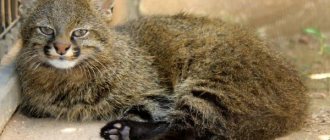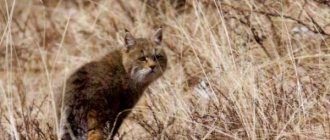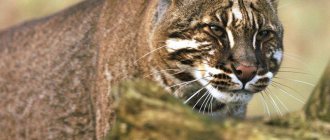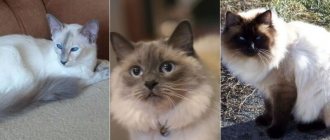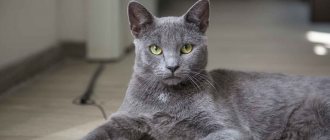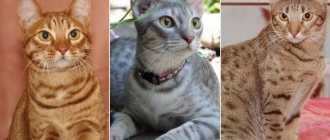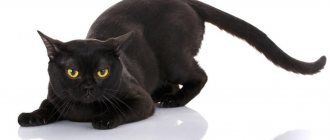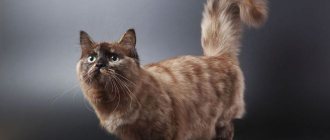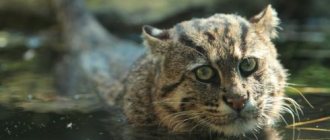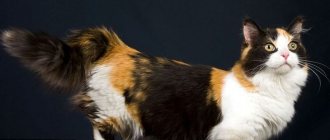When the first boom in fashionable exotic Serval pets passed, lovers of expensive “toys” became interested in other representatives of the cat family. Geoffroy's cat is also included in this list, because the animal is not very large in size, no larger than an ordinary pet, but its wild appearance and unusual behavior guarantees people's interest.
By the way, did you know how much a serval costs? In our article about these cats there is a section on the price of servals.
Description
Geoffroy is a small wild cat, about the size of a large domestic cat. According to genetic studies, it is most closely related to the Chilean cat, or Kodkod (Leopardus guigna). Sexual dimorphism is pronounced, males are larger than females. The length of the body, including the head, ranges from 422-665 mm, and the tail adds an additional 240 - 365 mm to the total length. Body weight is 3-5 kg, although an individual weighing 7.8 kg has been recorded. The height at the withers is about 30 cm. The color of the coat varies from silver-gray to yellowish-brown. The color of the coat depends on the habitat; yellower coat is found in individuals from the northern part, and grayer coat is found in southern cats. There are dark brown or black spots on the animal's body. Like most members of the cat family (Felidae), the underbelly is paler, usually cream or even white. Two black stripes run from the eyes to the neck. The animal's ears are large and rounded, the back is black with white spots. Melanism is quite common in this species. There are dark stripes on the tail and limbs.
Geoffroy's cats have been observed engaging in unusual behavior - standing on their hind legs, using their tail as a support, and observing the surrounding area. Similar behavior is observed in weasels, meerkats and prairie dogs, but generally not in felines.
Based on current geographic distribution, five subspecies of Geoffroy's cat have been identified:
L.g. geoffroyi – central part of Argentina;
L.g. euxantha – northern Argentina, western Bolivia;
L.g. leucobapta – territory of Patagonia;
L.g. paraguae – Paraguay, southeastern Brazil, Uruguay, northern Argentina;
L.g. salinarum
– northwestern and central parts of Argentina.
Lifestyle and character
Geoffroys are wild South American cats. They prefer to live alone. They only come into contact with their own kind during the mating season. These cats are not fans of climbing trees. They mark their territories and engage in fierce battles with strangers. Geoffroy hunts at night and sleeps during the day.
They feed on everything they can catch - rodents, insects, frogs, etc. The diet often includes hares, guinea pigs and birds. Geoffreys can even eat carrion. They hunt according to the standard pattern - tracking and sneaking up on the prey. Geoffroy is distinguished by one feature.
Sometimes, in order to look around, they stand up, like marmots, on their hind legs and lean on their tail. These cats are excellent swimmers. They are excellent fishermen, and are even able to evade pursuit in the water.
Habitat
Geoffroy's cats have a varied habitat and can be found at altitudes of up to 3,500 meters above sea level. They prefer open woodland or scrubland with plenty of vegetation, but are also found in grassland and marshy areas. Although cats can climb trees, they rarely do so except to mark their territory with feces.
Purchasing a Geoffroy kitten
You can try to buy a Geoffroy kitten in specialized nurseries, but they are very rare.
You should not buy a smuggled animal without a full set of documents; government authorities can simply seize the animal and fine the owner.
The cost of such an exotic pet is 7-10 thousand dollars.
Sometimes hybrid individuals are sold; girls are more valued here, so there is still some hope of getting offspring from them. Males of any offspring of interspecific crosses are sterile until at least the 4th-5th generation. In any case, do not forget about veterinary passports and certificates or pedigrees.
All animals should, like any pet, be regularly treated for worms and external parasites, and vaccinated against all known feline infections and rabies every year.
Reproduction
The female's estrus repeats every twenty days and lasts from two to six days. The mating system of this species is unknown. However, the home ranges of adult males overlap with several mature females, but do not overlap between males. This, combined with the larger size of the males, indicates some level of competition between males, and therefore polygyny.
The breeding season for cats occurs from December to May. Females can produce one litter per year, with one to four young. Geoffreys often mate in trees.
In females, the gestational period (pregnancy) lasts 67-78 days. Cubs are born in dens, rock crevices, and sometimes even in secluded corners of trees. Kittens weigh 65-123 g at birth. They are born blind, but open their eyes within 8-12 days. Geoffroy cat cubs develop quickly. They stand on their paws in four days, begin to walk at two to three weeks, and already at six weeks, the kittens are fearless climbers. These cats are weaned from their mother's milk at 8–10 weeks, and at eight months they become completely independent of their mother. Puberty occurs between 14 and 24 months of age.
Features of safari mating
As a rule, puberty occurs quite early in safari:
- in cats - at 6 months;
- in cats - at 8 months.
Under no circumstances should animals be bred at this age, since the body has not yet fully formed and become stronger. Early pregnancy will lead to weak offspring. Crossbreeding of safari dogs with related breeds (Bengals or wild cats) is allowed.
The basic rules for safari mating are the following requirements:
- animals must be healthy;
- The pet must look for a mate from professional breeders or in a breeding club;
- the use of any drugs, including hormonal ones, is prohibited;
- by the time of mating, both the male and female cats must be vaccinated against major feline diseases;
- on the day of mating, it is better to trim the animals’ claws so that they do not injure each other;
- mating occurs only in the cat's territory.
On average, the pregnancy of safari cats lasts 65–67 days, during this period it is necessary to carefully monitor the animal’s nutrition and gradually increase the diet.
Safari as a business
Being a breeder of a purebred animal is not as easy as it seems at first glance. On the one hand, the cost of a kitten of several thousand dollars is an excellent reason to start safari breeding, but on the other hand, you will need to follow all the nuances of breeding and invest considerable funds in the selection of the breed and its care.
Buying breeding stock is a very responsible process. Animals must have clear signs of their breed, as well as a passport and pedigree. However, a passport and other documents do not guarantee that the kitten will have good reproductive characteristics. Therefore, already at this stage there is a high risk of being left with nothing.
In addition, no one is insured against accidents or poor-quality food, as a result of which the cat may die. For purebred safaris, all standards of care and nutrition must be observed in order for them to grow into a healthy animal ready for breeding.
The cost of an individual largely depends on the color of the skin.
How to choose the right safari kitten
At the moment there are very few nurseries where you can buy safari. Most breeders live in the breed's homeland - the USA. Therefore, prices for kittens are very high: Safari is among the TOP 5 most expensive cats in the world.
The purchase of a purebred pet should be made only from a professional breeder or in a breeding club with a passport and pedigree. After all, this is the only way to guarantee compliance with breed standards and excellent health of the animal.
It is important to be able to distinguish a safari kitten from kittens of other “spotted” breeds. The future pet must have all the characteristics of its breed, without exception. Not only the shape of the body deserves special attention, but also the length of the tail, the set of the ears and the shape of the eyes
If any sign is not visible, it is better not to rush into the purchase:
Not only the shape of the body deserves special attention, but also the length of the tail, the set of the ears and the shape of the eyes. If any sign is not visible, it is better not to rush into the purchase:
- short and very dense coat;
- the whole body is covered with spots and rosettes - albeit not clear, but traceable patterns;
- dark rings on the paws and end of the tail;
- triangular head shape;
- developed vibrissal pads;
- large ears set high on the head;
- long and straight nose - without humps or dents;
- oval or almond shaped eyes;
- The eye color is uniform and always matches the coat color.
As a rule, nurseries and professional breeders offer exclusively purebred safari kittens for sale, as they protect their reputation. Buying an exotic breed from private breeders is highly discouraged.
A small kitten is very expensive, since the breed is still small and exclusive
The safari cat is a direct descendant of wild cats, has a bright leopard-like appearance and a very gentle character. The breed does not require care, but there are important nuances of feeding and maintenance.
Nutrition
These felines are not very picky eaters. Their diet includes a wide variety of animals, but the brown hare is their preferred food. However, Geoffroy cats will eat almost any type of meat they can get their hands on. They hunt in trees and on the ground, and also fish.
Their diet includes: birds, fish, amphibians, reptiles, rodents, wild guinea pigs, small agoutis, hares and other small mammals.
Self-study criteria
You can determine the breed of a cat yourself
To do this, you need to pay attention to the external distinctive features and compare them with the characteristic features of certain breeds
- I'm so typical...
If, after lengthy examinations and manipulations, it was not possible to identify the variety, the pet can be shown to a professional breeder or veterinarian. As an alternative, you can chat with cat lovers on specialized forums by showing them a photo of your pet.
You can distinguish an ordinary cat from a purebred one by the following characteristics:
Color. The color and length of the coat, the degree of coloring and pattern are some of the determining factors indicating belonging to a particular breed. Many purebred cats are characterized by the following colors: color point, smoky, blue, cream.
Body type
Attention is paid not only to the size and structure of the body, but also to the length of the legs and tail, and the location of the ears. Head shape
Most purebred animals have an elongated and graceful head shape.
Head shape. Most purebred animals have an elongated and graceful head shape.
This sign indicates possible belonging to Siamese, Oriental, Bengal cats. If the pet's face is flattened, this indicates that it belongs to exotics, Pallas's cats or British cats.
Ear shape. Drop ears are found in Scottishfold animals. Curved forward - in Scottish shorthair cats. Ears turned in the opposite direction are a feature of American Curls.
Eye shape and iris color. Some breeds only have one eye color. For example, Siamese cats can only have blue eyes, while Nibelung cats can only have green eyes.
Animal paws. If the limbs seem too short compared to the body, this indicates that the dog is a Munchkin or Minskin. Thin and long paws are a feature of the Savannah, Asher and Abyssinian cats.
Tail. A tail that is too short or, conversely, long and fluffy, can indicate “blue blood.”
A fluffy tail is one of the characteristics of the breed
It is worth considering that it is impossible to determine the breed of a cat only by the color of the animal’s coat and physique, since some varieties have a similar color and body structure.
Among purebred cats, the most popular colors are:
- Blue. It is characterized by a gray-blue tint, without spots, stripes or inclusions of other colors. This coloring is typical of the Russian Blue, Scottish, British Shorthair and Nibelung cats.
- Siamese. It is characterized by a darker muzzle, ears, tail and paws. The fur coat on the body must be several tones lighter. This color is found in Thai, Himalayan, Balinese and Neva masquerade cats.
- Sandy and creamy. One of the rarest colors, which is characteristic of the Abyssinian and Somali cats.
- Chocolate. It is more common among the British and Scots.
- Tabby (striped). This color indicates belonging to a particular breed only if it is symmetrical. The most popular breeds with this coat color are the British, Siberians, Kuril Bobtails and Scots.
To increase the chance of correctly identifying the breed by color, you must also take into account the length and thickness of the coat.
Symmetrical stripes also indicate thoroughbred
On a note! The easiest way to determine the breed of a kitten is to take a photo of it and use the “search by image” function on the Internet.
Behavior
Geoffreys are primarily nocturnal, but have been observed hunting at dawn and dusk. They love water and are avid swimmers. Secretive and solitary, cats spend most of their time in trees. Geoffroy's cats are known to sleep and breed in trees. They are quite flexible and can even walk on lower branches. Males and females do not interact with each other except during the breeding season. The home ranges of females occupy about 2.5 square kilometers. Males' territories can be three times larger than females'. The ranges of females may overlap with other females as well as males. Although males overlap the ranges of females, they do not overlap the territories of other males. The density of cats per ten square kilometers is about 1.2 individuals. Most people are not afraid of this little cat, but they should be because it is a very aggressive animal that has never been truly domesticated.
Geoffroy's cat has good camouflage due to its coat color, but this is believed to be primarily used for hunting (i.e., to hide the cat from prey rather than from predators).
The rarest spotted cats
Leopard-colored cats are also among the new experimental breeds that have not yet found recognition.
Australian Smoke (Mist)
Breeder Labor Street from Sydney carried out enormous selection work, which involved simple and purebred cats - Abyssinian, Siamese, Burmese. Among the many colors, tabby is one of the most common.
Mist inherited excellent health from the barn cats, and extraordinary grace and dignity from the elite. Gets along well with any pet, is devoted to people, loves children, is active and energetic. Approved by a limited number of felinological organizations, it is not widely distributed.
California radiant
Despite its wild appearance, this is not a hybrid breed, but a mixture of many varieties of cats - British Shorthair, Manx, Siamese, Angora, Abyssinian.
Created by American screenwriter Paul Casey as a symbol of wild African cats, mercilessly destroyed by humans. Very smart, friendly, silent and undemanding pets are still very rare and are registered only in the TICA felinological system (USA).
There are eight colors - black, brown, blue, bronze, charkoal (smoky anthracite), red, gold and silver. Always tabby.
Ussuri cat
This natural breed was noticed relatively recently. Most likely, it came from crossing Amur and Siberian cats.
It has been registered as experimental since 1994, but so far its representatives are very rare in the world.
The main color is from golden to fawn, always tabby. A very independent, self-sufficient and proud pet has all the habits of a predator. Temperamentally, he is more like the latter. Doesn't get along well with other animals, is a loner by nature and an excellent hunter.
Soukok or Sokoke (Kenyan Forest Cat)
It is believed that the ancestors of this very rare breed are wild kazonzo and secondarily feral domestic cats.
Through the efforts of the English breeder Jenny Slator, the breed was approved in 1992 in Denmark.
These slender and lithe cats are small in size, but strong and muscular. The dense and short coat can be of different colors, but always tabby, usually merle.
Playful and very intelligent animals are quite willful and independent. At the same time, they get along well with both humans and other pets. Wonderful hunters.
Threats
The fur trade had a significant impact on the decline of Geoffroy's cat population. Their skins rank second in sales on the international market (red lynx fur takes first place).
In central Argentina, human-related mortality of this species accounted for 62% of total fatalities, including poaching, killing by domestic dogs and collisions with vehicles. Cats were also killed for meat and poultry hunting.
There is a huge demand for exotic pet species, with Geoffroy cats being illegally captured and crossed with domestic cats to create hybrid pets known as “Safari cats”.
The deterioration of the cats' habitat is associated with deforestation. However, recent studies in Argentina have shown that this species can live in the resulting open areas.
Captivity
Man has repeatedly tried to tame Geoffroy's cat, as well as to obtain hybrid offspring from her. Doing this is more difficult than socializing even an ocelot, and even this animal is not easy to communicate with.
It was noted that male Leopardus geoffroyi, placed in a common enclosure with female domestic cats, as a rule, refused to mate and quickly killed the latter, but when raised together from an early age, exceptions to this rule are possible.
Geoffroy's females, on the other hand, easily bred with domestic cats. In both cases, the offspring are most often born sterile, which is associated with a different chromosome set (36 pairs in Geoffroy, 38 in a domestic cat, 37 in a hybrid individual).
Only a small Geoffroy kitten can be trained; an adult cannot be socialized.
It is better to feed a three or four month old baby only by hand, so that he quickly gets to know his owner and recognizes him.
The cubs are active and playful, but they must be handled very carefully. These animals show high dexterity, and their teeth and claws are very sharp.
It is strictly not recommended to raise an exotic pet using shouting or physical punishment; the animal may be seriously offended and take revenge.
It is advisable to place an adult pet in a spacious enclosure with an area for active games and climbing. This cat loves heights and will strive to climb there in any conditions. The animal does not like cramped spaces, and may even get sick from lack of physical activity.
It’s a good idea to teach your kitten to walk on a leash or harness from an early age and to take your pet for walks regularly.
The predator should be fed only raw lean meat; you can feed any bird, as well as day-old chicks, quails, mice, and fish. Ready-made industrial food is not suitable; the animal will not even sniff it. Don't forget about vitamins and minerals. An adult will need from 400 to 900 grams of meat per day.
Geoffroy's cat can be found everywhere in zoos around the world, as well as in nature reserves and national parks.
Kitten from the street: precautions
If the kitten was simply picked up on the street, then it needs to be put in a box or bag and taken not home, but to the veterinary clinic. You can't wash it now. If there are too many fleas and they are clearly bothering the baby, then you can use drops on the withers or a spray. The veterinarian will examine the pet, conduct the necessary examinations (for ringworm, infectious diseases, etc.) and after weighing, advise how and how to clean it of parasites (worms, fleas).
A street kitten must be shown to a veterinarian, who will examine it and take the necessary tests.
If there are other pets at home (dogs, cats, etc.), the foundling is kept in quarantine in a closed and isolated room (bathtub, pantry, balcony, etc.), excluding any contact between animals. If the kitten does not show any suspicious or alarming symptoms, it looks cheerful and healthy, then after two weeks it is released into the common space. Then, following the recommendations of the veterinarian, the necessary vaccination is carried out.
If the selected baby is emaciated and very thin, then you need to feed him extremely carefully. You should not give cow's milk, it is better to use special cat milk substitutes
If the poor thing can already eat solid food, then little by little wet food for kittens is given.
Very small kittens will have to be fed with special formulas
If the kitten has injuries (dog bites, paw dislocations, etc.), only a veterinarian can help. At the clinic, the bite sites will be treated and, if necessary, stitches will be placed, and the necessary medications (antibiotics) and wound treatment products will be prescribed. You will have to treat the wounds daily for several weeks, since bites usually take a long time to heal. A foundling that is limping and dragging its paw should be immediately shown to a veterinarian, who will correct the dislocation or perform the necessary surgical operation. Only after applying a fixing bandage can the pet be taken home for rehabilitation.
WHAT DOES IT EAT?
At night, Geoffroy's cat goes in search of food. Long, elastic, very sensitive whiskers help the animal navigate and hunt in the dark, and thanks to soft paw pads and retractable claws, the cat moves absolutely silently. Geoffroy's cat feeds mainly on small mammals and birds, but from time to time it also hunts frogs and lizards. If a cat lives near a pond, it often fishes.
Best articles: What animals live in Asia - list of species, photos and characteristics
The cat waits for prey, sitting in ambush. This predator reveals its presence only when the prey can no longer escape. The cat moves deftly through trees, so prey only in some cases manages to escape its claws. Thanks to its protective coloring, this predator is completely invisible in the twilight against the background of branches and leaves. Geoffroy's cat has excellent hearing. With its help, she determines the location of the prey.
If a cat manages to catch a rodent on the ground, it kills it with one bite and immediately eats it. It tears large prey into pieces and only then swallows each piece separately. Unlike big cats, which often manage to catch prey weighing a third of their body weight (they feed on it for a week), Geoffroy's cat must go hunting sometimes twice a day in order to get enough food.
Features of caring for domestic cats
A loving owner cares about the health of his pet. Spotted felines are active and curious, so they sometimes get injured. You need to carefully monitor their behavior and, if possible, prevent trouble.
All pets must be vaccinated against infections. This will protect your furry pets from many deadly diseases. In general, spotted cats do not require any specific care. They need to be cared for just like any other furry pet.
Grooming
Almost all spotted cats are short-haired, so brushing them once every 1-2 weeks is sufficient. Cats are very clean animals, so they only need to be washed if the pet gets dirty in something.
Cats keep their fur perfectly clean
Food for spotted cats
These animals are very active and spend a lot of energy, so they need a balanced, nutritious diet, like all other cats. It is advisable to feed them the best premium food that contains all the necessary nutrients.
Your cat's diet should be balanced
The spotted cat is a source of joy in the home. You can admire her endlessly. Motley beauties need care and love.
Cat breeds that look like tigers look very attractive and unusual. These days, such pets are no longer uncommon, but this was not always the case.
The American geneticist P. Casey was involved in crossing wild and domestic animals with a spotted coat. The result is that spotted cats have become suitable for living with humans.
Features of safari mating
As a rule, puberty occurs quite early in safari:
- in cats - at 6 months;
- in cats - at 8 months.
Under no circumstances should animals be bred at this age, since the body has not yet fully formed and become stronger. Early pregnancy will lead to weak offspring. Crossbreeding of safari dogs with related breeds (Bengals or wild cats) is allowed.
The basic rules for safari mating are the following requirements:
- animals must be healthy;
- The pet must look for a mate from professional breeders or in a breeding club;
- the use of any drugs, including hormonal ones, is prohibited;
- by the time of mating, both the male and female cats must be vaccinated against major feline diseases;
- on the day of mating, it is better to trim the animals’ claws so that they do not injure each other;
- mating occurs only in the cat's territory.
On average, the pregnancy of safari cats lasts 65–67 days, during this period it is necessary to carefully monitor the animal’s nutrition and gradually increase the diet.
Safari as a business
Being a breeder of a purebred animal is not as easy as it seems at first glance. On the one hand, the cost of a kitten of several thousand dollars is an excellent reason to start safari breeding, but on the other hand, you will need to follow all the nuances of breeding and invest considerable funds in the selection of the breed and its care.
Buying breeding stock is a very responsible process. Animals must have clear signs of their breed, as well as a passport and pedigree. However, a passport and other documents do not guarantee that the kitten will have good reproductive characteristics. Therefore, already at this stage there is a high risk of being left with nothing.
In addition, no one is insured against accidents or poor-quality food, as a result of which the cat may die. For purebred safaris, all standards of care and nutrition must be observed in order for them to grow into a healthy animal ready for breeding.
The cost of an individual largely depends on the color of the skin.
Characteristics
Cats are very sociable and require human attention. They get along well with other animals and get along with children. Animals are somewhat shy with strangers.
Some cats behave reservedly, but most representatives of the breed are playful and moderately active. By the way, a distinctive feature is the behavior characteristic of dogs in games: “catch and fetch”
Cats happily fetch a thrown ball, enjoying the game and attention from humans. After playing or eating, cats prefer to take a nap, not alone, but in the company of another cat or owner.
Havana is not suitable for too busy people, because
It is important to have contact with animals and devote a lot of time to them. Cats will not sit quietly next to you, they prefer to climb on your lap and even pester you a little, which can be annoying if the owner is tired after work.
However, their pestering is touching; they attract attention by gently touching their hands and faces with their paws.
Purebred kittens should only be purchased from nurseries with trusted breeders. The largest number of nurseries is in the USA, but they also exist in Russia, Europe and the CIS countries. The initial cost is about thirty thousand rubles. Depends on the gender, color intensity and class of the cat.
The price becomes higher if you purchase a pet with a good pedigree and a show career. If these indicators are important to you, be prepared to pay from sixty to one hundred thousand rubles.
As a rule, kittens begin to be sold in the fifth month after birth. By this time, they are already absolutely independent and vaccinated. Remember that at the moment there are just over a hundred purebred individuals registered, so be careful when choosing a breeder and adequately assess the cost of the kitten.
Havana Brown breed
- Bombay cat: description and characteristics of the breed
- Features of the American Shorthair cat breed
- Review of the European Shorthair breed: appearance and care
- Review of the Devon Rex breed: breed characteristics, appearance, proper care
- Review of the Egyptian Mau breed: features, proper care, price
- Review of the Himalayan cat breed: origin, appearance, character and care
- Review of the Canadian Sphynx breed: appearance, care and care, nutrition
- Snow-Shoe cat breed: description, care and health, price
The Havana Brown is a very affectionate and loving animal. Human society is simply vital for a cat. The kitten gets used to its new family very quickly, it is moderately playful and active. As a cat grows up, it becomes more sociable and talkative. However, the Havana is not annoying; if she sees that the owner is busy, then the cat will not disturb him.
Animals of this breed are very fond of heights; they can master any heights. Often, a cat finds a cozy place higher off the floor. With children and other animals, the Havana Brown is friendly and calm. The cat will never let out its claws or show aggression, even in a critical situation. Thanks to its balanced character, it is an ideal animal for large families.
This breed is rare in Russia today. Basically, representatives of the oriental breed of Havana color are popular, with which browns are confused out of ignorance. You can buy a Havana Brown kitten in Novosibirsk, at the Elvenkingdom cattery.
The cost of a kitten is clarified by the breeder and depends on the purpose of the purchase. Even as a pet, a Havana Brown will cost a considerable amount of money.
Subspecies
Five subspecies of this predator are known, living in different regions of South America. They differ somewhat in size and color, but lead the same lifestyle, similar in behavior and taste preferences.
If you look at photos of Geoffroy's cats of different subspecies, you will notice that the inhabitants of the southern part of the range are larger than their northern relatives and have a gray coat color. The fur color of the northern subspecies is brownish-yellow.
The smallest of the subspecies lives in western and central Argentina - Leopardus geoffroyi salinarum. The largest subspecies lives in central Argentina - Leopardus geoffroyi geoffroyi.
Appearance
Geoffroy's cat is built very proportionally, looks graceful and elegant:
- The length of the body including the tail is no more than a meter.
- The male's body is 55 - 75 cm in length, the female's - 39 - 51 cm.
- The tail of animals is of medium length - 20 - 35 cm, thick, fluffy.
- The male weighs 3.5 - 6 kg, the female - 2.5 - 3 kg.
- The head is round in shape with an elongated muzzle.
- The eyes are large, swamp-colored, with vertical, lentil-like pupils.
- The nose has a wide bridge, pink with black edging around the periphery.
- The ears are rounded at the ends, erect, 4.5 - 5 cm high, with a white edge inside, black behind and with a white spot.
- The paws are the same length as those of an ordinary domestic cat, although somewhat more massive and with wider feet. Retractable claws.
- The whiskered predator, like any other South American cat, has a spotted color. The main color of the coat is gray or yellowish-brown. The coat is short, medium fluffy, soft. The spotted pattern consists of multiple black spots with a diameter of 1.5 - 2 cm and short stripes. The spots in the center of the back are located in pairs, on the sides and paws - in single elements. Black stripes on the muzzle in the forehead area are located vertically and horizontally near the eyes. From three to seven longitudinal stripes run along the back of the neck and the back of the head. Stripes are also visible on the legs and tail. The very tip of the tail is black. The belly and lower part of the neck are cream colored.
